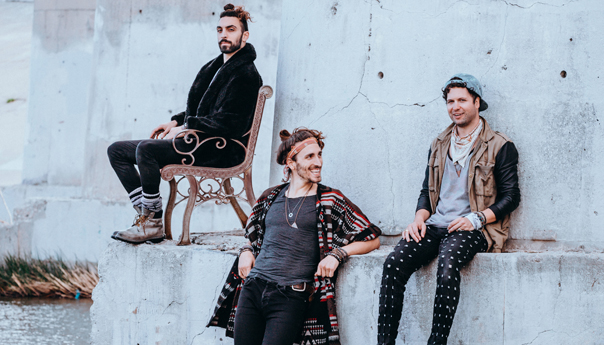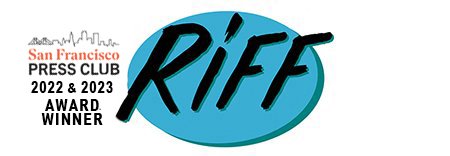Q&A: Magic Giant finds music in nature on In The Wind

Courtesy: Brantley Gutierrez
From the redwoods on Northern California’s coast to fields of daisies in Crested Butte, Colorado, folky pop band Magic Giant returns with In The Wind, an album as musically diverse as the locales in which it was recorded.
Magic Giant, Armors
9 p.m., Friday
Popscene at Rickshaw Stop
Tickets: $14-$39.
The band concluded its creation journey for In The Wind (out May 19) at its Silver Lake studio Singer Austin Bisnow, banjo and violin player Zambricki Li and guitarist-cellist Zang were then joined by producer Ben Allen (Walk the Moon, MIA) who organized the finished songs and gave them a common thread, Li said.
Magic Giant’s songs are decidedly folksy and incorporate instruments as diverse as orchestral drums, banjos, trumpets, saxophones, harmonicas, synths, cellos, violas, violins, dobros, lap steels and mandolins. This blend suits a variety of tastes.
The band is hitting the road, and San Francisco is the first stop. We chatted with Zambricki Li in advance of the band’s Friday show at Popscene about finding music in awe-inspiring destinations and how Li learned to play violin in just days after—and this is true—suffering a brain trauma known as Acquired Savant Syndrome.
RIFF: How did you guys get together? What inspired Magic Giant?
Zambricki Li: At first Austin and I had a different band, played a few shows in Los Angeles, and took a hiatus. A booker who had seen one of those early shows and didn’t know we were no longer performing, sent an offer for a big festival. Austin instinctively said yes and called me. [He] said, “We’re getting the band back together!” After that, Austin found Zang performing on bass at an L.A. club, and upon looking him up in a Google search, discovered he was a world-class salsa dancer as well as a fantastic musician. We convinced Zang to join the band and Magic Giant was formed. From the start we wanted to move bodies and souls with a high energy show and a lot of dancing!
When did you first get into music, and how? What was your first time learning an instrument?
Austin broke his ankle playing basketball and his parents signed him up for a songwriting camp while he was immobile and he instantly fell in love with it. Similarly, but way more extreme, I got hit by a car when I was 13, fell into a coma, and when I woke, learned violin in a few days through a rare brain trauma reorganization now known as Acquired Savant Syndrome. Zang started playing upright bass in grade school because he wanted to be the coolest kid in school carrying around the biggest instrument.
What bands or artists have inspired your music? Who do you look up to?
We love the organic vibe and dynamics of bands like the Lumineers, Queen for their harmonies and inventive forms, Bruce Springsteen for his longevity and energizing show. The Killers have been an influence on mixing dance elements with rock; Edward Sharpe and the Magnetic Zeros for their super-compelling live festival sets, and Julian Casablancas for his lyrics and courage to be different.
You’re starting your tour on the West Coast and San Francisco is the second show, but you will be playing in many cities and at many musical festivals all over the world. Is there a festival or city that you are most excited to play?
That’s a difficult question! Really excited to play Firefly Festival in Delaware which has an amazing lineup in a unique way that they engage the fans in selecting who performs. We’re really excited about Arroyo Seco which is a first-year festival, with Tom Petty and the Heartbreakers, Mumford and Sons and Alabama Shakes. We’re really grateful to be able to play festival this huge in our hometown of Los Angeles.
Have you spent much time in the Bay Area before?
We love hanging out at Alamo Square and wandering through Golden Gate Park. San Francisco is quirky, and so are we, so it’s a good fit. The Fillmore was a super-fun and iconic [venue], and The Chapel is a really special venue. We had a blast playing there.
What things, people or events inspired your upcoming album?
A lot of the songs on the album are about the triumph of the human will. We’re capable of more than we realize, sometimes. We all have low points in life [and] it’s on us to turn it around. It doesn’t matter who’s to blame or credit; we’re all in this together. A lot of things happened over the last few years as we were writing the album and even more as were recording it. We’ve made lifelong friendships and lost loved ones. [We] got to see some of the most beautiful places in the country and a whole lot of sunrises.
Magic Giant recorded In The Wind in a mobile recording studio, all over the U.S. Were there any places that inspired some of the tracks? What about being on the road helped you musically?
Powder Mountain, Utah has a hidden lake (shhhh) where we recorded guitar on the song “Jade.” We also ended up writing an important part of the song there. While in Crested Butte, Colorado, we found an epic wildflower field like something out of the Sound Of Music and we got some really compelling vocals there. In Washington State there’s a 3-mile tunnel through a mountain in the Snoqualmie Pass and we got some great echoes and reverbs that we used all over the album. We drove the long way from Seattle and found a redwood tree in Humboldt … that was the size of a recording studio with the perfect reverb; very woody. Being on the road and playing festivals in-between recording helped us flesh out the songs in front of a live audience before we laid [them] down. It also allowed us to live the music 24 hours a day. When we weren’t playing shows we were looking for places to record and mapping out acoustical anomalies along the way. Quite an adventure!
Describe your setup as you recorded on the road. Was the mobile studio a trailer? What equipment did you stock it with?
We wanted to have a minimal environmental impact so we got a turbo diesel bus, added solar panels to the top of it and tricked it out so we could access our gear and microphones on the fly. [We] brought with us a Nuemann m147 microphone for vocals and violins, a Shure sm7 and bunch of other microphones for the sounds we found along the way. We brought a little Neve microphone preamp and used an Apogee interface and converters.
Is the song “Jade” based on a real person?
“Jade” is a song that we started in Canada and evolved as we wrote it on the road. We were playing it [at shows and it] didn’t have a title. … At a festival, a fan came up to us and told us a story about how her childhood best friend committed suicide. She was 16 and [the fan] felt her presence as we were playing the song. As we kept writing the song her word stayed with us and her story became part of the story the song. Her friend who passed was Jade.
Follow columnist Troy Van Skike at Twitter.com/Trox_Macgee.
